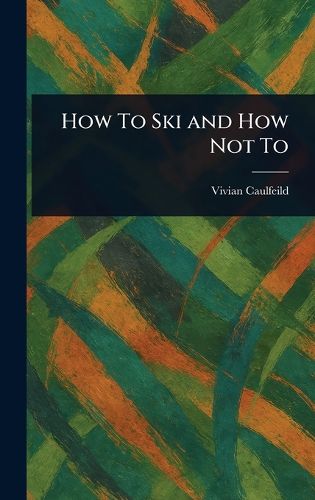Readings Newsletter
Become a Readings Member to make your shopping experience even easier.
Sign in or sign up for free!
You’re not far away from qualifying for FREE standard shipping within Australia
You’ve qualified for FREE standard shipping within Australia
The cart is loading…






This title is printed to order. This book may have been self-published. If so, we cannot guarantee the quality of the content. In the main most books will have gone through the editing process however some may not. We therefore suggest that you be aware of this before ordering this book. If in doubt check either the author or publisher’s details as we are unable to accept any returns unless they are faulty. Please contact us if you have any questions.
"How To Ski and How Not To" by Vivian Caulfeild is a timeless guide to the art and science of skiing. This meticulously prepared edition preserves the original insights and techniques, offering a fascinating glimpse into the early days of winter sports. Whether you're a seasoned enthusiast or simply curious about the history of skiing, this book provides valuable instruction on fundamental skills and safety practices.
Delve into Caulfeild's expert advice on skiing techniques, equipment, and navigating the snowy slopes. Discover the principles that underpin successful skiing, and learn how to avoid common pitfalls. Perfect for anyone interested in the history of skiing or looking to understand the roots of modern ski instruction. A classic text reborn for enduring enjoyment.
This work has been selected by scholars as being culturally important, and is part of the knowledge base of civilization as we know it.
This work is in the public domain in the United States of America, and possibly other nations. Within the United States, you may freely copy and distribute this work, as no entity (individual or corporate) has a copyright on the body of the work.
Scholars believe, and we concur, that this work is important enough to be preserved, reproduced, and made generally available to the public. We appreciate your support of the preservation process, and thank you for being an important part of keeping this knowledge alive and relevant.
$9.00 standard shipping within Australia
FREE standard shipping within Australia for orders over $100.00
Express & International shipping calculated at checkout
This title is printed to order. This book may have been self-published. If so, we cannot guarantee the quality of the content. In the main most books will have gone through the editing process however some may not. We therefore suggest that you be aware of this before ordering this book. If in doubt check either the author or publisher’s details as we are unable to accept any returns unless they are faulty. Please contact us if you have any questions.
"How To Ski and How Not To" by Vivian Caulfeild is a timeless guide to the art and science of skiing. This meticulously prepared edition preserves the original insights and techniques, offering a fascinating glimpse into the early days of winter sports. Whether you're a seasoned enthusiast or simply curious about the history of skiing, this book provides valuable instruction on fundamental skills and safety practices.
Delve into Caulfeild's expert advice on skiing techniques, equipment, and navigating the snowy slopes. Discover the principles that underpin successful skiing, and learn how to avoid common pitfalls. Perfect for anyone interested in the history of skiing or looking to understand the roots of modern ski instruction. A classic text reborn for enduring enjoyment.
This work has been selected by scholars as being culturally important, and is part of the knowledge base of civilization as we know it.
This work is in the public domain in the United States of America, and possibly other nations. Within the United States, you may freely copy and distribute this work, as no entity (individual or corporate) has a copyright on the body of the work.
Scholars believe, and we concur, that this work is important enough to be preserved, reproduced, and made generally available to the public. We appreciate your support of the preservation process, and thank you for being an important part of keeping this knowledge alive and relevant.